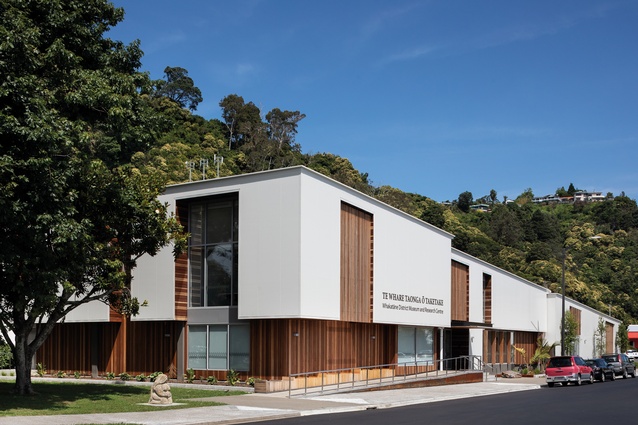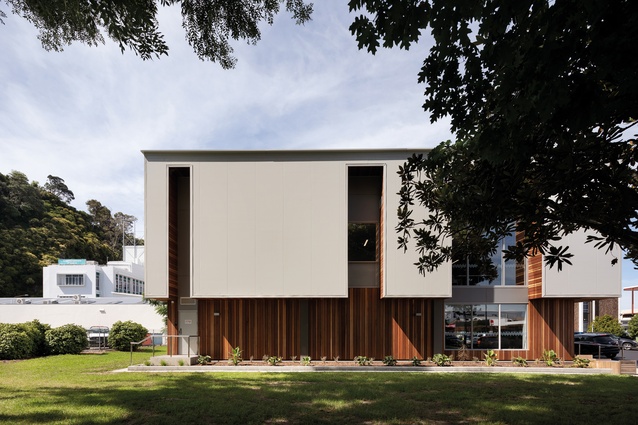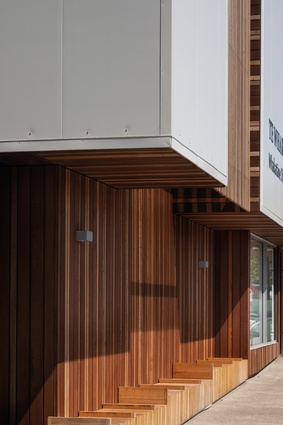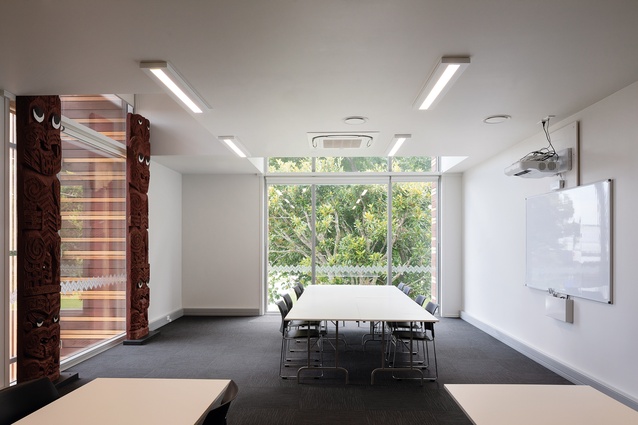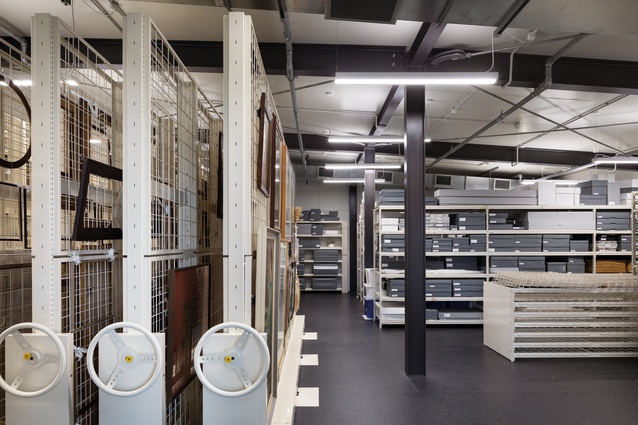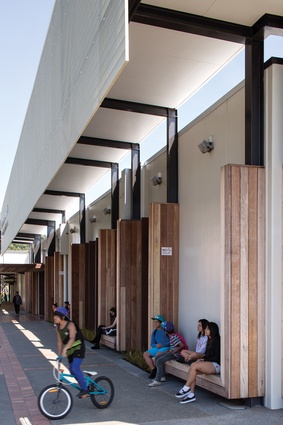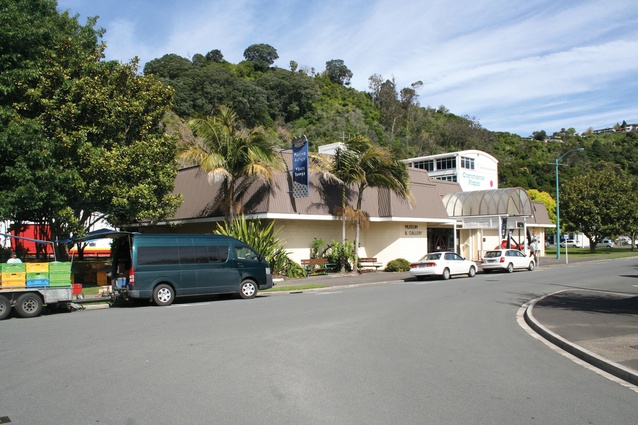Cool store collection
Chris Barton engages with Irving Smith Architects’ freezer-panel-encased refurbishment of the Whakatāne District Museum and Research Centre, Te Whare Taonga ō Taketake, and the changing face of museum collections.
The refurbishment of the Whakatāne District Museum and Research Centre, Te Whare Taonga ō Taketake, is described by Irving Smith Architects as an archiving of the archive. The Nelson-based firm is referring to how the building deals with the hodgepodge of what was there – a collection of blockwork buildings alongside Boon Street, expanding outwards from the original 1970s’ museum, which had a lean-to added to the south in the ’80s and a two-level collection store to the north in the ’90s.
All was capped with a rather regrettable mansard roof. Entry in the middle was via an arched tunnel of plastic half-hoops – popular in ’80s’ shopping malls – that protruded across the footpath beside an old tractor engine set into concrete. From here, visitors turned right to the main exhibition space or left into a space that was part storage, part exhibition. Upstairs was an ever-increasing jumble of museum collection storage and administration functions sitting on a floor literally groaning under the ever-increasing weight.
Irving Smith’s job here had begun 10 years ago, as the first stage of the Whakatāne District Council’s Arts and Culture project. An abandoned Briscoes store on Kakahoroa Drive beside the Whakatāne River and near the intersection of Boon Street and the town’s main drag, The Strand, was retrofitted into a library and exhibition centre – Te Kōputu a te whanga a Toi – which opened in 2012. As well as providing a library for the town, the building includes an adjoining exhibition centre comprising a semi-permanent museum display area and three changing art gallery spaces.
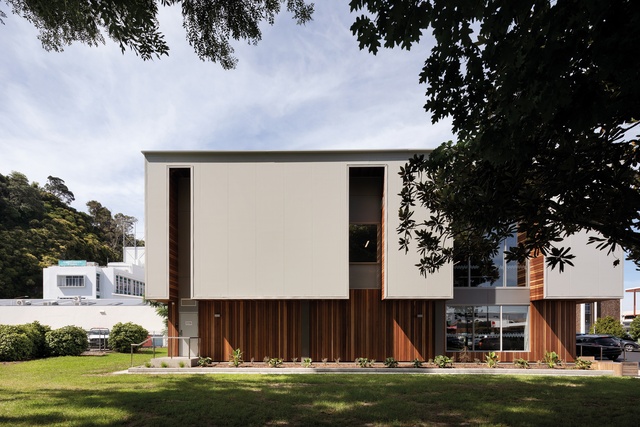
At first it seems a bit confusing, as though the town has two museums, one at the library and one at the far end of Boon Street, which it kind of does. The library exhibition space provides the general public face of the museum collection storehouse, a sample of its taonga and treasures.
Back at 51–55 Boon Street, Irving Smith set about the second stage of the Arts and Culture project, which began as the Research, Storage and Archives project and morphed into the redevelopment of the Whakatāne Museum. The archiving of the archive rapidly became something of a logistics nightmare – not just in the decanting of some of the collection off site and to other parts of the existing buildings, but also in figuring out just how big the existing museum collection was and how big it might become.
The design solution dispensed with the lean-to at the south and the eccentric hoopla entrance, plus the in-situ tractor engine, but kept pretty much everything else. It was a multi-sustainable move. “The existing building held value, memory and thermal mass,” says lead architect Andrew Irving. It then seemed entirely logical to encase the two original buildings with a lid of titanium white Bondor insulated freezer panels – providing a well-insulated, cost-effective envelope. An archive in a fridge at a total building cost of $4.1 million (1530m2 new building and 967m2 refurbished, excluding landscaping and fitout), roughly $2600 per sqm.
The effect is dramatic – a raking roof line running along Boon Street, reading as three separate parts. It begins with two levels at the northern end, opening onto a playground park. It houses public research and viewing rooms in the former collection store at the ground level, plus staff and education spaces. Lighter small object and art collections, staff work areas and a large multifunctional community room are housed on the upper level. In the middle is a canopy entrance, reception and the archives in the former museum space. To the southern end is the new building accommodating a large collection store, access, accession areas and a plant room.
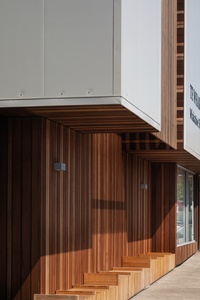
Irving Smith was acutely aware that such long form on the street could be visually challenging. “We didn’t want to do a supermarket,” says co-designer Jeremy Smith, indicating the Countdown around the corner. The design question, says Irving, was: “How and where, if we are going to make a white box, can we incorporate something warm? And how do we make a white box that reads like a roof rather than like a wall?”
The solution came by using cedar cladding at the base of the building, the wood warming from beneath and infiltrating upwards to warm across the windows that cut into the white fridge lid on top. The use of ‘tiger stripe’ redwood heart cedar – a mix of two widths and two colours (light and dark) – is a nod to continuity with the library building, which uses the same cladding. The timber is also emblematic of the clustering of non-critical, public functions at the street edge where there is a row of outdoor seating against the Boon Street wall – an activating schema that speaks to the public nature of the building.
Inside, is a vast collection valued at $9.5 million, comprising 600,000 photos, 100,000 objects and more than 650 boxes of community and accessible council archives. By far the most valuable is the Taonga Māori collection, which includes significant examples from Ngāti Awa, Ngāi Tūhoe, Ngāti Tūwharetoa, Ngāti Rangitīhī and Te Whakatōhea. There’s also the Te Kōhika collection, comprising prehistoric archaeological material examples from one of the most significant swamp excavations in New Zealand.
Other holdings include: the hatchet of the chief Tītokowaru of the New Zealand wars, the finely carved Te Maungarongo amo, well known internationally to researchers of tribal art, the Pink family daguerreotypes, some of the earliest forms of photograph in the world, and a rare Resolution and Adventure medal from Cook’s second voyage.
It’s also a collection in constant flux. When we visit, newly appointed Collections and Research Manager Mark Sykes shows us some recent acquisitions, which include beautifully intricate 16th-century heru (ornamental combs). Such taonga sit alongside an eclectic mix of what seems to be everything anyone has imagined might be worth keeping – bicycles, game consoles, washing machines, stoves, printing presses, pumps, picture frames and, of course, doilies of which there seem to be about 400.
While some of this vast collection is on display in the library exhibition space, most of it is here on, or in, various types of shelving and drawers. Some is visible but much is not, including vast stacks yet to be ‘deboxed’. Such is the way of museums, where collections are constantly being reviewed with some items inevitably destined for ‘deaccession’.
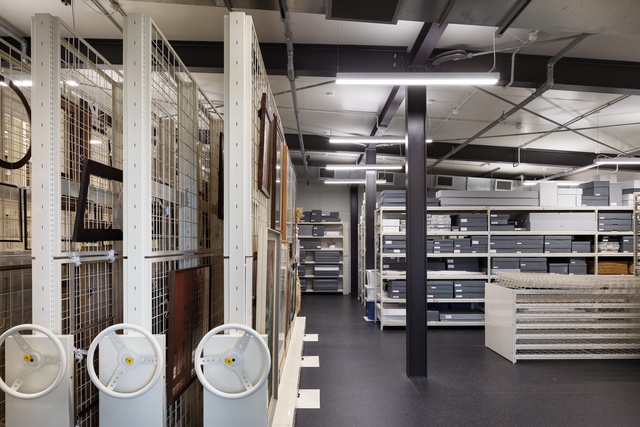
On the ground floor of the redeveloped facility, there are two storage areas, one for community archives and the other for large objects, a decontamination area and a loading bay. Upstairs, a large multifunctional space can be used as a meeting room or a viewing room for various collection displays.
The idea here is that collections can be used to connect the community with the past and with each other. Having recently run an open day where the public could come inside the storage areas to see much more than usual, Sykes is keen for more of the collection to be more accessible. Such ‘open storage’ allows general public access to the museum collection in the hope of raising interest in research and the aspects of the collection itself.
A key move, says Sykes, in realising this vision, is to change some of the shelving, particularly the parts storing carvings, which currently lie horizontally, some insensitively stacked on top of one another. Sykes wants them standing. “It’s about their mana; the carving and the carver and the person he’s representing.”
While we’re there, Sykes explains how the shelving arms can be repurposed to do just that. Designing buildings that can adapt to change is a key tenet of Irving Smith’s practice. While open storage was not stipulated as a ‘must-have’ in the museum design brief, it was highlighted as an avenue not to be discounted. With Sykes clearly seeing how open storage can work, it seems the building was always ready and waiting to let its treasures breathe. As Sykes puts it: “When you get things out of boxes, they get their life again.”
This article first appeared in Architecture New Zealand magazine.


